|
|
|
Sort Order |
|
|
|
Items / Page
|
|
|
|
|
|
|
| Srl | Item |
| 1 |
ID:
121291
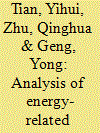

|
|
|
|
|
| Publication |
2013.
|
| Summary/Abstract |
With China's increasing pressures on reducing greenhouse gas (GHG) emission, Chinese iron and steel industry (ISI) is facing a great challenge. In this paper, we address the energy-related GHG emission trajectories, features, and driving forces in Chinese ISI for 2001-2010. First, energy related GHG inventory for ISI is made for both scope 1 (direct emissions) and scope 2 (including imported electricity emission). Then, the driving forces for such emission changes are explored by utilizing the method of logarithmic mean Divisa index (LMDI) decomposition analysis. Results indicate that Chinese ISI experienced a rapid growth of energy related GHG emission at average annual growth rate of 70 million tons CO2e. Production scale effect is the main driving factor for energy related GHG emission increase in Chinese ISI, while energy intensity effect and emission factor change effect offset the total increase and energy structure has marginal effect. Construction, manufacture of general purpose and special purpose machinery and manufacture of transport equipment sectors are main sectors for embodied emissions, amounting for more than 75% of the total embodied emissions from Chinese ISI. Such research findings propose that a detailed consideration can help make appropriate polices for mitigating ISI's energy-related GHG emission.
|
|
|
|
|
|
|
|
|
|
|
|
|
|
|
|
| 2 |
ID:
133215


|
|
|
|
|
| Publication |
2014.
|
| Summary/Abstract |
The current project-based carbon market mechanisms such as the Clean Development Mechanism (CDM) and the Joint Implementation (JI) do not have a direct impact on global greenhouse gas emission levels, because they only replace or offset emissions. Nor do they contribute to host country×s national greenhouse gas emission reduction targets. Contributions to net emission reductions in host countries is likely to become mandatory in new mechanisms under development such as in the framework for various approaches, a new market-based mechanism and even in a reformed JI. This research analysed the question if approaches for carbon market-based mechanisms exist that allow the generation of net emission reductions in host countries while keeping project initiation attractive. We present a criteria-based assessment method and apply it for four generic options in existing mechanisms and derive implications for future mechanism frameworks. We identified the application of "discounts" on the amount of avoided emissions for the issuance of carbon credits and "standardisation below business as usual" as most promising options over "limiting the crediting period" and "over-conservativeness". We propose to apply these options differentiated over project types based on internal rate of return to ensure cost-efficiency and attractiveness.
|
|
|
|
|
|
|
|
|
|
|
|
|
|
|
|
| 3 |
ID:
125469


|
|
|
|
|
| Publication |
2013.
|
| Summary/Abstract |
Comprehensive inventory of cities' greenhouse gas emissions (GHG) is the basis for cities to make appropriate mitigation plans. However, previous studies on cities' GHG emissions consider emissions occurring within the city boundary (Scope 1) and out of boundary electricity emissions (Scope 2), but neglect indirect emissions associated with commodities consumed by cities (Scope 3), resulting in emission leakage. To cope with this problem, a systematic accounting covering all 3 scopes is presented in a case study of Macao for the years 2005-2009, based on the latest embodied emission intensity databases for China and for the world. The results show that total emissions are dominated by indirect emissions mainly embodied in imports, which is 3-4 times direct emissions during the period concerned. It is verified that accounting under Scopes 1 and 2 cannot capture the full picture of cities' emissions, especially cities like Macao which are dominated by service industry and inevitably sustained by massive materials and services from other regions. Our study suggests that Macao should adjust its current GHG mitigation policies which consider only its emissions occurring within its border, as Macao is a net GHG emissions importer. This work is the first assessment of Macao's embodied GHG emissions.
|
|
|
|
|
|
|
|
|
|
|
|
|
|
|
|
| 4 |
ID:
133144
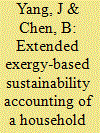

|
|
|
|
|
| Publication |
2014.
|
| Summary/Abstract |
Biogas has been earmarked as one of the leading renewable energy sources capable of mitigating environmental emissions in rural areas. Thus, developing an accounting technique is of particular importance in coping with increasing problems related to renewable agriculture and rural energy supply. In this study, extended exergy was generalised for the sustainability evaluation of biogas projects. Furthermore, a series of extended exergy-based indicators was presented as benchmarking from the perspectives of resources, economics and greenhouse gas (GHG) emissions. The sustainability of a "Three-in-One" biogas production system in southern China was thereby evaluated based on the proposed framework. The results show that economic costs concentrate in the construction phase. GHG emissions are mainly derived from bricks and cement, with proportions of 36.23% and 34.91%, respectively. The largest resource depletion occurs during the consumption of feedstock (87.06%) in the operation phase. Compared with other renewable energy conversion systems, the biogas project has a higher renewability (0.925) and economic return on investment ratio (6.82) and a lower GHG emission intensity (0.012). With the merit of bridging thermodynamics and externality, the extended exergy-based approach presented in this study may effectively appraise the energy and environmental performance of biogas projects.
|
|
|
|
|
|
|
|
|
|
|
|
|
|
|
|
| 5 |
ID:
087141
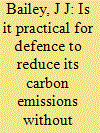

|
|
|
|
|
| Publication |
2009.
|
| Summary/Abstract |
Climate change is one of the most significant threats to global stability and requires rapid, widespread action to limit its effects. Of this action, the legislative requirements to reduce global carbon emissions will impact on all spheres of economic activity. In the United Kingdom, Defence activity currently contributes approximately 1 per cent o the national carbon emissions total. This paper researches the subject of Defence carbon emissions, a sparsely researched field, by using information from academic, contemporary data sources, government and Ministry of Defence sources. Many consider that adapting to low carbon solutions will adversely affect military performance and effectiveness. This paper will argue that the reality is that military capability can be enhanced by adopting the energy efficiency measures and technological solutions that are both available today and those that are likely to emerge as cost effective alternatives in the coming decades. It will demonstrate that by building on the emission reductions already realised, Defence can develop and implement low carbon capabilities and practices aligned to the developing low-carbon economies and continue to deliver practical capability solutions to counter future threats.
|
|
|
|
|
|
|
|
|
|
|
|
|
|
|
|
| 6 |
ID:
166721
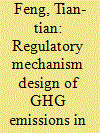

|
|
|
|
|
| Summary/Abstract |
As one of the key industries of CO2 emissions, the electric power industry plays an important role in China's response to climate change. Recently, the electric power industry has achieved a certain amount of emission reductions through optimizing power structure and enhancing energy efficiency. However, the efforts to address climate change still lack of orderly management and supervision. In order to fulfill the goals of ‘Notice of the 13th Five-Year Work Plan for Controlling GHG emissions’ in China, that by the end of 2020 CO2 emissions per unit of GDP should decrease by 18% compared with that in 2015, there is an urgent need to establish and innovate regulatory mechanisms for Greenhouse gases (GHG) emissions in the electric power industry. This study discusses the status quo and existing problems of GHG emissions regulation of the electric power industry in China from the perspectives of regulatory agencies, measures and accounting methods. Then based on the regulatory experiences from developed countries and combined the real-life characteristics in China, a new GHG emissions regulatory index system and supervision scheme for the electric power industry is established. Finally, some recommendations are proposed for further regulatory mechanism innovation of the electric power industry in China.
|
|
|
|
|
|
|
|
|
|
|
|
|
|
|
|
| 7 |
ID:
124629


|
|
|
|
|
| Publication |
2013.
|
| Summary/Abstract |
A significant proportion of the world's greenhouse gas emissions can be attributed, directly or indirectly, to corporate activities. An increasing number of companies have set targets and have adopted initiatives to reduce their greenhouse gas emissions, raising the question of what sorts of outcomes can realistically be expected from corporate action on climate change? This paper aims to shed some light on this issue through an analysis of the climate change performance of the UK supermarket sector. This sector is directly responsible for around 1% of UK greenhouse gas emissions, but it has been estimated that indirectly it may be responsible for up to 10% of emissions. In the period between 2000 and 2010, the major UK supermarkets transformed their approach to climate change. This paper examines the outcomes that resulted from these actions. It finds that there have been significant and steady improvements in energy efficiency, but that these efficiency gains are often outstripped by the impacts of business growth. For most companies, short of a radical redesign of their business activities, or an expansion of the scope of their energy management initiatives to include their indirect emissions, total greenhouse gas emissions will tend to increase over time.
|
|
|
|
|
|
|
|
|
|
|
|
|
|
|
|
| 8 |
ID:
133290


|
|
|
|
|
| Publication |
2014.
|
| Summary/Abstract |
Using energy data over the period 1981-2011 we find that US biofuels subsidies and production have provided a perverse incentive for US fossil fuel producers to increase their rate of extraction that has generated a weak green paradox. Further, in the short-run if the reduction in the CO2 emissions from a one-to-one substitution between biofuels and fossil fuels is less than 26 percent, or less than 57 percent if long run effect is taken into account, then US biofuels production is likely to have resulted in a strong green paradox. These results indicate that subsidies for first generation biofuels, which yield a low level of per unit CO2 emission reduction compared to fossil fuels, might have contributed to additional net CO2 emissions over the study period.
|
|
|
|
|
|
|
|
|
|
|
|
|
|
|
|
| 9 |
ID:
181425
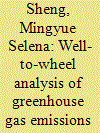

|
|
|
|
|
| Summary/Abstract |
Electric Vehicles (EVs) are regarded as a feasible solution to achieving decarbonisation in the transportation sector. However, EVs powered by fossil dominated energy sources may offer a discounted solution. This paper presents a comparative study of Australian and New Zealand’s vehicle markets on Greenhouse Gas (GHG) emissions and energy consumption using well-to-wheel analysis. A vehicle uptake projection model is proposed to predict future uptake of EVs and associated emissions under three scenarios with different mix of EVs. Our empirical results suggest that, with the current electricity mix, in terms of energy consumption, Battery Electric Vehicles (BEVs) perform better than other types in New Zealand and Australia. Emission wise, BEVs emit 90% less GHG than the second-best option Plug-in EV in New Zealand, and 40% less than the second-best, Fuel Cell EVs (FCEVs), in Australia. In the long run, as more “green hydrogen” is produced, FCEVs will play a critical role in minimising emissions. Emissions in the two countries are predicted to reach their peak around 2030, provided that BEVs form the major portion of the EV mix with a higher penetration of renewables and more FCEVs enter the fleet. The empirical outcomes provide important policy insights to support decision making.
|
|
|
|
|
|
|
|
|
|
|
|
|
|
|
|
|
|
|
|
|